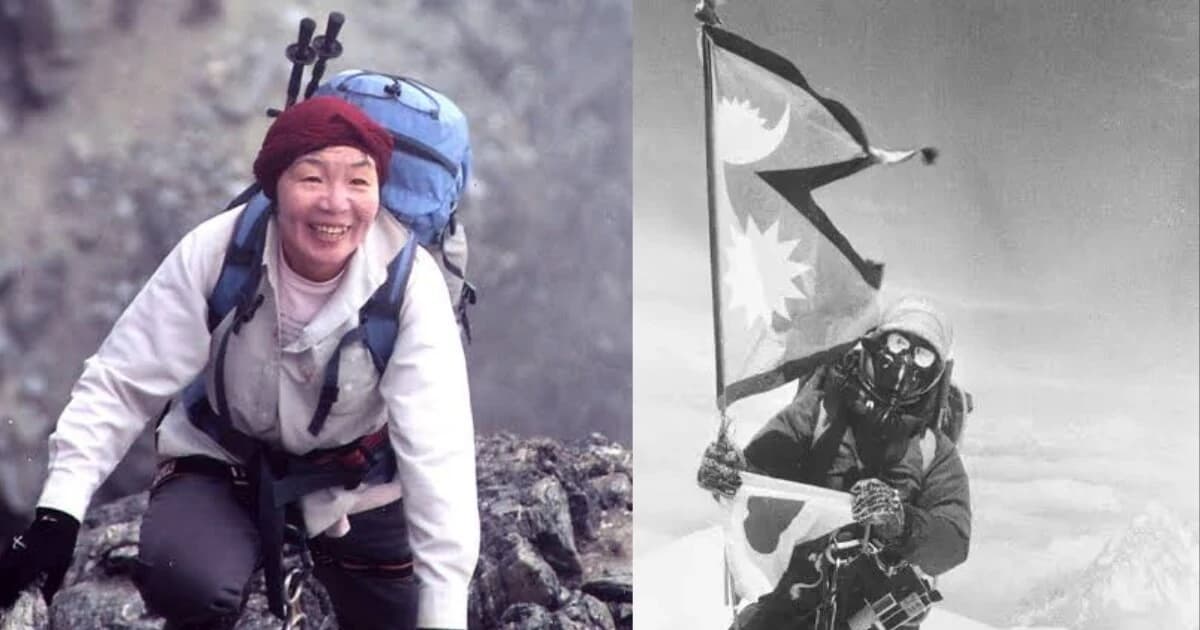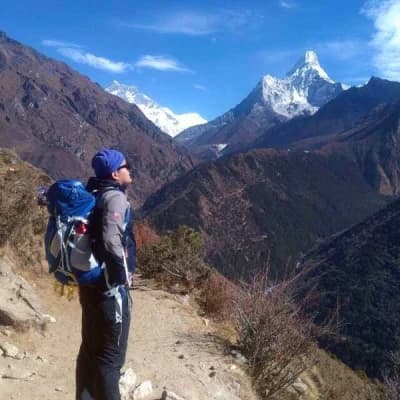Mount Everest is the highest mountain in the world, standing tall at 8,848.86 meters (29,032 feet). Located in the Himalayas on the border between Nepal and Tibet, it symbolizes adventure and challenge for climbers worldwide.
In this blog, we will learn who the first woman to climb Mount Everest was and discuss some notable achievements of other female climbers.
Has A Woman Ever Climbed Mount Everest?
Yes, many women have climbed Mount Everest. The first woman to climb Mt. Everest was Junko Tabei from Japan, who reached the summit on May 16, 1975. Since then, over 883 women have climbed the world’s highest peak. These incredible women have proven that determination and courage can conquer even the tallest mountains.
Who Was The First Woman To Climb Mount Everest: Junko Tabei
Junko Tabei, a Japanese mountain climber, was the first woman to reach the summit of Mount Everest. She accomplished this incredible feat on May 16, 1975. Despite facing numerous challenges, including last-minute funding issues, Junko persevered and reached the world’s top.
>Explore Our amazing Saipal Himal Base Camp Trek
What Was Junko’s Childhood Like, And What Made Her Interested In Climbing?
Junko Tabei was born on September 22, 1939, in Miharu, Japan. Growing up in a small town near Fukushima, she was a quiet and petite child who enjoyed spending time outdoors. Her passion for climbing began at age ten during a school trip to Mount Nasu. The thrill and beauty of the mountains captivated her, sparking a lifelong love for hiking and climbing.
The Everest Expedition of Junk Tabei
In 1971, Junko Tabei and her team from the Joshi-Tohan Club set their sights on Mount Everest. After four years of waiting for their permit, the Japanese Women’s Everest Expedition (JWEE), led by Eiko Hisano, embarked on their journey in May 1975. The team of 15 women faced significant challenges, including making their gear and securing last-minute funding. Each member contributed 1.5 million yen (around $5,000).
Following the route taken by Sir Edmund Hillary and Tenzing Norgay in 1953, the team encountered an avalanche on May 4, 1975, at 20,700 feet, which buried Junko and four other climbers. Despite losing consciousness, Junko was rescued and continued the climb after two days of rest. With limited oxygen supplies, Junko was chosen to make the final ascent.
On May 16, 1975, Junko Tabei, alongside her sherpa guide, Ang Tsering, reached the summit of Mount Everest, making her the first woman to stand at the top of the world’s highest peak.
Who Was The First Nepali Woman To Climb Mount Everest?
Pasang Lhamu Sherpa was a pioneering Nepalese mountaineer and the first Nepali woman to reach the summit of Mount Everest, achieving this historic feat on April 22, 1993. Unfortunately, her triumph turned tragic when she died during her descent due to harsh weather conditions. Her accomplishments made her a national hero and an icon for female empowerment in Nepal. Pasang Lhamu Sherpa’s legacy inspires women in Nepal and worldwide to pursue their dreams and break through barriers. In honor of her contributions and her trailblazing spirit, several institutions and awards in Nepal have been named after her, keeping her memory and influence alive.
Journey of Pasang Lhamu Sherpa in Mountaineering
Pasang Lhamu Sherpa’s journey to the summit of Mount Everest is a profound story of resilience, courage, and groundbreaking achievement. Born on December 10, 1961, in a small village in the Solu Khumbu District of Nepal, Pasang Lhamu grew up in the shadows of the world’s highest peaks, a region famed for mountaineering challenges.
Early Life and Inspiration
Pasang Lhamu was inspired by the mountains surrounding her from a young age. As a member of the Sherpa community, she was deeply connected to mountaineering. Her family, including her mountain guide father, was involved in trekking and expeditions, which fueled her passion for climbing.
Stepping into Mountaineering
Pasang Lhamu started her mountaineering career by participating in smaller climbs and gradually took on more challenging expeditions. Despite the societal expectations and cultural norms that often restricted women’s roles in her community, she persisted with her ambitions, driven by a desire to stand equal to men in mountaineering.
The Quest for Everest
Multiple attempts marked Pasang Lhamu’s quest to climb Everest. She first tried to reach the summit in 1990 but had to turn back. Undeterred, she made subsequent attempts in 1991 and 1992, facing difficult conditions and setbacks each time. Her perseverance was a testament to her determination to climb Everest and break the gender barrier in her community.
Historic Summit and Tragic End
On April 22, 1993, after several grueling attempts, Pasang Lhamu Sherpa and her expedition team finally reached the summit of Mount Everest. Her success was a monumental moment for Nepal, especially for Nepali women, as she became the first Nepali woman to conquer the peak. However, the triumph was short-lived. During the descent, she faced terrible weather and tragically lost her life near the South Summit.
Legacy and Recognition
Pasang Lhamu Sherpa’s legacy extends far beyond her mountaineering achievements. She is remembered as a pioneer who challenged and changed the gender norms within her community and country. Her determination and achievements have inspired countless Nepali women to pursue their dreams in various fields, especially sports and outdoor activities.
Numerous memorials and initiatives, including schools and mountaineering awards, have been named after her in honor of her contributions. Pasang Lhamu Sherpa’s journey and ultimate sacrifice on Everest are powerful reminders of the human spirit’s capacity to reach new heights and forge new paths.
Who Was The First American Woman To Climb Mount Everest?
The first American woman to climb Mount Everest was Stacy Allison. She achieved this remarkable feat on September 29, 1988. Her success set a record and served as a huge inspiration, showing that with grit and perseverance, the sky’s the limit—or in her case, the peak of the world!
Stacy Allison
Stacy Allison, born in 1958 and raised in Woodburn, Oregon, made history on September 29, 1988, as the first American woman to reach the summit of Mount Everest, the world’s highest mountain. Her remarkable achievement was a milestone for American women in mountaineering, showcasing her determination, skill, and courage.
What Motivated Her Passion for Climbing the World’s Tallest Peaks?
While studying biology at Oregon State University, Stacy Allison discovered her passion for climbing. At 21, she attempted her first significant climb on Mount Huntington. Although she and her climbing partner had to turn back just 200 feet from the summit due to a broken ax, this experience only fueled her determination. Stacy continued to climb, and in 1988, she made history as the first American woman to reach the summit of Mount Everest.
She later joined a team that achieved the first successful all-women ascent of Ama Dablam, a 22,495-foot peak. Her motivation and drive led her to another remarkable achievement when she led a successful expedition to the summit of K2 on July 7, 1993.
Recommended Read: How Cold is Mount Everest?
Who Was The First Black Woman To Climb Mount Everest?
Sophia Danenberg is the first Black woman to climb Mount Everest. She reached the summit on May 19, 2006. She conquered the highest peak in the world and paved the way for future generations of climbers by showing that the mountains are for everyone, no matter their background. Her achievement highlights the importance of diversity and inclusion in adventure and exploration.
Sophia Danenberg
Sophia Danenberg, born in 1972, is an American mountain climber renowned for being the first African American and Black woman to summit Mount Everest, the world’s tallest mountain. Besides her impressive climbing achievements, Sophia is actively involved in local and national politics and serves as a Washington State Park Commissioner. She is biracial, with a Japanese mother and a Black father, and her diverse background adds to her inspiring story.
What Got Her Started With Mountaineering?
Sophia Danenberg’s passion for mountaineering began as a Fulbright Fellow at Keio University in Tokyo, where she first tried rock climbing. This experience ignited her love for climbing and adventure. After graduating magna cum laude from Harvard University with a degree in Environmental Sciences and Public Policy, Sophia’s interest in the natural environment further fueled her climbing ambitions.
Initially planning to summit Cho Oyu, she switched to Everest due to monsoon conditions, deciding just one week before the climb. At 34, Sophia was challenged to climb Everest unguided, choosing her route, carrying her gear, and making all decisions independently.
On May 19, 2006, despite suffering from bronchitis, frostbite, and a clogged oxygen mask, Sophia reached the summit of Everest, becoming the first African American and Black woman to achieve this feat. Her determination and passion for climbing were critical motivators in her mountaineering journey.
Challenges Faced By Female Climbers
Physical Challenges
Women face unique physical challenges in mountaineering due to physiological differences, such as lower muscle mass and different metabolism rates, and must also endure extreme high-altitude conditions, harsh weather, and the need for rigorous training and preparation.
Societal Challenges
Women face several societal challenges in mountaineering, including traditional gender roles, stereotypes, and limited freedom compared to men. Society often expects women to prioritize family and caregiving roles, which can restrict their opportunities for adventurous pursuits like climbing. Female climbers frequently encounter stereotypes and bias, with some doubting their capabilities in physically demanding activities.
Gender Bias
Women in mountaineering often face significant gender bias, which can manifest as doubts about their physical and mental abilities, less recognition for their achievements, and fewer leadership opportunities. They frequently encounter skepticism, are overlooked for sponsorships, and receive less media coverage than their male counterparts.
Access to Resources and Support
Women in mountaineering often struggle with limited access to resources and support compared to males. They may find it more challenging to secure funding and sponsorships, which are crucial for affording gear, training, and travel expenses. Additionally, there can be fewer mentorship opportunities, making it harder for women to connect with experienced climbers who can offer guidance and advice.
Safety Concerns
Safety is paramount for all climbers, but women may face additional risks and challenges. Female climbers often have to deal with the lack of appropriately sized gear and equipment, impacting their safety and performance. Personal safety concerns can also be more pronounced for women, especially when traveling and camping in remote areas.
Check out this blog here to learn how to train and prepare for your EBC Trek!
How Many Women Have Successfully Summited Mount Everest?
As of January 2024, 6,664 people, including 883 women, have climbed Mount Everest 11,996 times using all routes. Additionally, 35 climbers have crossed the mountain from one side to the other.
Achievements Of Notable Female Climbers
Junko Tabei
In 1975, Junko Tabei from Japan, the first woman to climb Mount Everest, reached the summit and became the first woman to complete the Seven Summits by climbing the highest peak on each continent.
Stacy Allison
Stacy Allison made history in 1988 as the first American woman to summit Mount Everest. She continued her impressive climbing career by leading a successful expedition to the summit of K2 in 1993.
Sophia Danenberg
Sophia Danenberg became the first African American and Black woman to summit Mount Everest in 2006. Her ascent is celebrated as a significant milestone in the diversification of mountaineering.
Wanda Rutkiewicz
Polish climber Wanda Rutkiewicz was the first woman to successfully climb K2, the world’s second-highest peak 1986. She was also the third woman to summit Everest, achieving this feat in 1978.
Gerlinde Kaltenbrunner
Austrian climber Gerlinde Kaltenbrunner became the first woman to climb all 14 of the world’s 8,000-meter peaks without supplemental oxygen in 2011. Her remarkable endurance and skill have set a high standard in the mountaineering community.
Edurne Pasaban
In 2010, Spanish climber Edurne Pasaban became the first woman to climb all 14 8,000-meter peaks. Her dedication and perseverance have earned her a place among the top mountaineers in the world.


.webp&w=1200&q=75&dpl=dpl_2PwU5ZDv8uoJ3KrzEVbz8N547HgX)
.webp&w=1200&q=75&dpl=dpl_2PwU5ZDv8uoJ3KrzEVbz8N547HgX)
.webp&w=1200&q=75&dpl=dpl_2PwU5ZDv8uoJ3KrzEVbz8N547HgX)